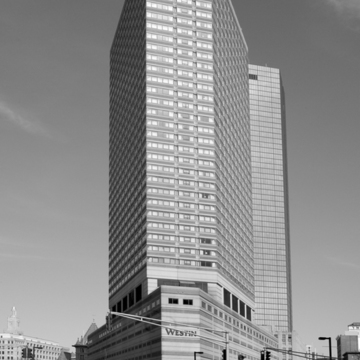A prominent and enormous site (9.5 acres, including air rights above the Massachusetts Turnpike and railroad tracks) became the locus of the largest single-phase private development in New England until that time. Here, on prime real estate, rose a suburban-type shopping mall anchored by the Westin and Marriott hotels. The Westin constitutes the main entrance at the junction of Dartmouth and St. James streets, a six-story building with bands of striped dark and light pebble aggregate, which envelopes a high-rise tower. Passages lined with elegant boutiques, restaurants, cafés, and a cinema complex, as well as apartments and provisions for parking, connect to the Marriott. Flyovers spanning circulation arteries link to the newly remodeled Prudential Center (BB79) shopping complex. Dimitri Hadzi's Waterfall, composed of a seductive array of rare stones, is the centerpiece of the shopping complex, forming a natural meeting place.
It is difficult to believe that this most ordinary group of buildings, in terms of massing and materials, resulted from an elaborate design process, led by Tunny Lee, then professor of architecture at MIT, together with a citizens' review committee and local residents whose interests were taken into account by the Urban Investment and Development Company. Copley Place may lack architectural distinction, and its suburban aspect is at odds with the urban fabric in the heart of the city, but this climate-controlled and readily accessible complex is very popular.




















